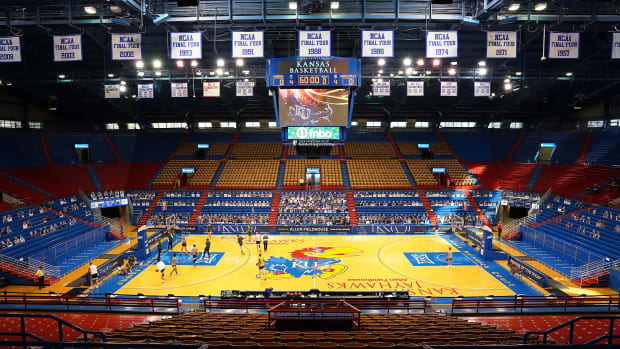With Texas and Oklahoma ready to jump ship, can the conference salvage the hoops' side of things?
The best conference in men's college basketball is on thin ice.
Since the last round of conference realignment, no league has been as consistently great in the sport as the Big 12. It has ranked in the top two of KenPom’s conference rankings all but once, sent four different programs to the Final Four and cut down the nets in 2021 with Baylor.
But in major college athletics, decisions are made because of football and the television revenue that comes with football. And with Texas and Oklahoma seemingly on the verge of jumping ship for the king of football (the SEC), the eight other schools that have played a huge role in making the league a men's basketball power are left in flux. Can Kansas, Baylor and the rest of the Big 12’s hoops elite keep up in the college sports arms race without the money machine that Texas and Oklahoma football helped create?

In the last 25 years, Kansas men’s basketball has ranked third in KenPom’s “program ratings." It has finished in the top 25 of the analytic site's rankings in 24 of the last 25 years, falling out for the first time this year to a still-impressive No. 27 nationally. Meanwhile, Baylor now has men’s and women’s basketball national titles in the last three years after its men’s team cut down the nets in Indianapolis this spring.
Beyond that current power duo, Texas Tech recently completed construction of one of the nicest practice facilities in the country, and West Virginia has earned a top-five seed in five of the last six men's tournaments. These programs are well funded and have blossomed into consistent powers, but a seismic realignment like this has the potential to disrupt their success.
Yet while men’s basketball has been made a priority by Big 12 programs, history tells us future conference affiliations will be made almost entirely with football in mind. Look at UConn, which was left scrambling when the old Big East collapsed and wound up in the American Athletic Conference. But playing East Carolina and Tulsa instead of Providence and Georgetown in basketball wasn’t ideal, to say the least, so the Huskies eventually course-corrected by heading to the new Big East and shifting football to independence.
Such moves are even more complicated for several of these Big 12 programs, located in areas that eat, sleep and breathe college football, and with enough historical success to make FBS football irrelevancy a complete nonstarter. Even Kansas, by far the least football-obsessed Big 12 school, seems incredibly unlikely to make a clear basketball-over-football maneuver like UConn did in moving to the new Big East.
If the soon-to-be remaining eight Big 12 schools were to stick together and expand by adding Group of 5 schools, the financial hit they’d take would be significant. Texas and Oklahoma football games are the most valuable inventory in the portfolio right now, and those will be gone. If that happens, can the basketball powers maintain their elite level on the floor? Any belt-tightening at a time when SEC athletic departments are becoming even more flush with cash could have significant implications on retaining top coaches, assistant coaching salary pools, facilities upgrades and the like.
There’s also the potential for a more significant reshuffling, either in the form of a conference merger or other departures for greener (and more lucrative) pastures. Those could help protect some or all of the remaining Big 12 schools financially but could have trickle-down effects on recruiting. Kansas or Baylor moving to, say, the Big Ten or Pac-12 would be great financially given the alternatives but would change things like recruiting footprints.
It’s all quite messy, to say the least. Even simply the uncertainty of it all could impact recruiting in the short term. Some coaches in the league are finding out information through Twitter while sitting courtside at recruiting events this weekend, pondering the implications of it all without hard answers to give to anyone.
The current Big 12 may not feel nearly as synonymous with college basketball as the old Big East, but it’s currently staring down a similar fate. As currently constructed, the Big 12 has been great for men's college hoops. All 10 teams have earned a No. 6 seed or better at least once in the last five NCAA tournaments. The rivalries are strong, the fan bases are passionate and the coaches include an intriguing mix of personalities. Perhaps most importantly, programs have risen to new heights in recent years, particularly Baylor under Scott Drew and Texas Tech under Chris Beard. Not watching these 10 teams compete against each other every year will be a loss for the sport.
That said, the chain reaction that Texas and Oklahoma’s impending move could set off has a chance to shape which conferences and programs control the next decade or more in the sport. The SEC stands to get richer, and that rising tide should lift all boats—including men’s basketball programs. But the next maneuvers for those left behind in the Big 12 will be the ones that dictate who stays among the elite and who falls back.
And the paradox of it all: Those maneuvers will likely have very little to do with basketball.
Let the realignment games begin.
More Big 12/SEC Coverage:
• Texas A&M Can't Outrun the Longhorns
• Texas, OU Take Key Step Toward Leaving Big 12
• OSU President 'Disappointed' About Oklahoma's Exit